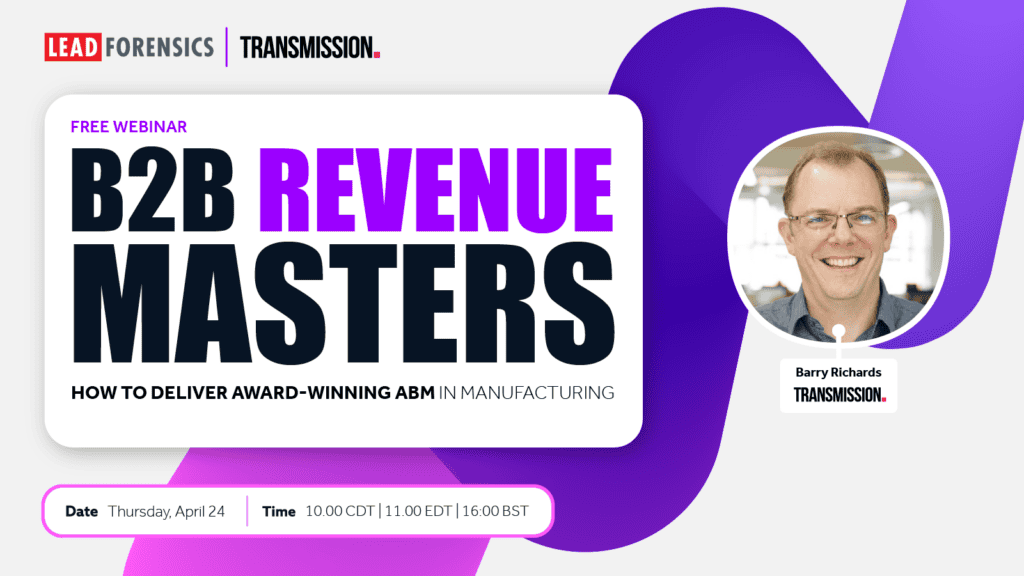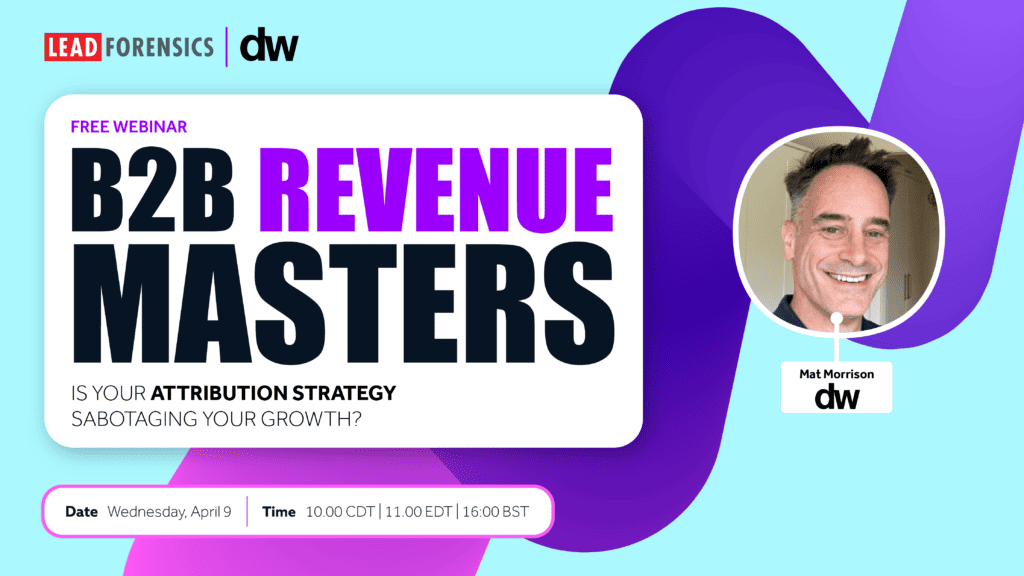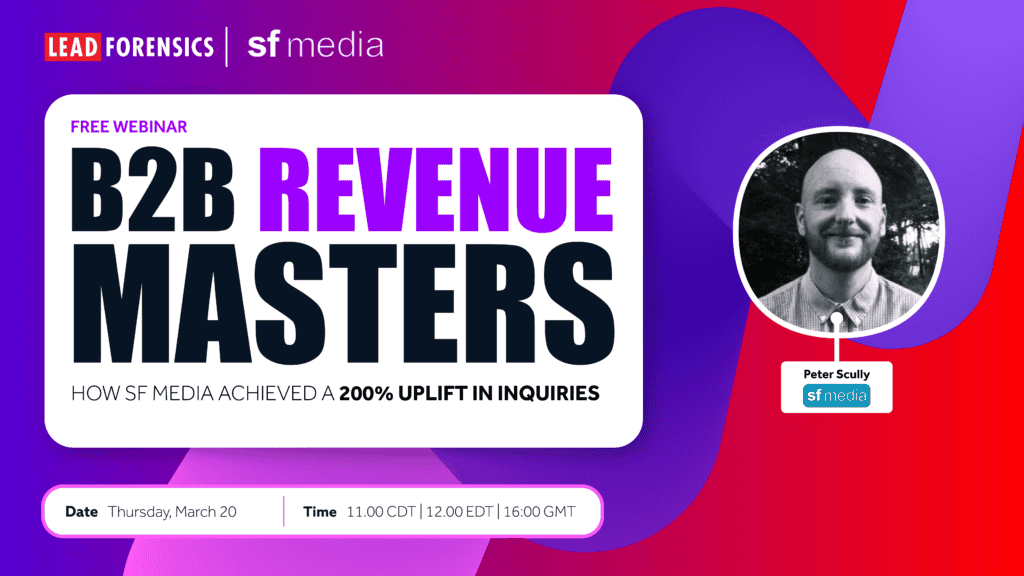Advanced objection handling
After marketing has worked its magic and a lead has been successfully generated, nurtured and qualified, it’s time for sales to jump into action. Nine times out of ten that means a sales rep will now reach for the phone to speak to a potential prospect and get a sales conversation underway.
If it goes badly, then you’re unlikely to get a second shot at it, so you need to be playing your ‘A’ game from the start. The good news is that with the right preparation and armed with the right information, you’ll be well on your way down the road to success.
Webinar topic detail
This webinar covers:
1. Prioritizing common objections
2. Temperature checks
3. Final stage of sale
4. Story-telling
Hello everyone, I just want to welcome you along today to the Lead Forensics webinar. My name is Holly, I’m the EMEA Event Marketing Manager here at Lead Forensics and I am going to be hosting today’s session. Following on from our last webinar where I discussed tactical ways to get past the gatekeeper, we are going to be exploring all things objection handling which is a necessary skill for every successful B2B sales rep.
Today, we are going to be covering prioritising your most common objections, temperature checks, the final stage of the sale, closing all the doors, story-telling and recording interactions.
At Lead Forensics, we know a thing or two about business to business sales . Not only do we have a world class, global sales team but our innovative software was designed with B2B in mind and we’ve been helping to support pipelines, fill the top of the funnels, speed up processes and supercharge those sales teams for more than a decade now. Our software works by identifying the previously anonymous visitors that land on your website so our tool provides you with business name, valuable contact details, visitor insights, equipping you with all that you need to open that sales conversation. It’s a valuable addition to any B2B technology stack, really helping businesses to prospect constantly, maximise your return on investment and integrating seamlessly with any CRM system.
As leaders in the world of B2B sales, handling objections is something we are often asked for advice on and quite a few of you if you’ve attended our webinars before will have also requested it, so it’s great that we are covering this topic today.
According to Hubspot, 35% of sales reps say overcoming price objections is their greatest challenge. Price is just one factor that your prospect might state as a reason not to commit to the sale. B2B sales leaders need to be prepared for eventualities and that includes the various objections that they face. Whether you are new to sales or you just want a refresher on overcoming objections, today’s session is going to be helpful for you. So, we’ll get started.
Prioritise your most common objections
Throughout the sale process you will face numerous objections no matter what you are selling. They will vary depending at what stage your buyer is at. For example, objections at the appointment booking stage will be different to those in the final stages of the close. We’ll break down the process into key stages that we will refer to later. They might look like
The initial call
Booking an appointment
The proposal stage
Follow up call
The close
Businesses often get bogged down trying to handle hordes of objections but instead it’s important to understand the most common objections that you face and perfect your response to those. We’re not saying you won’t need to practice them all because you will, but even with the best B2B sales leaders you won’t be able to overcome every single objection. If they’re familiar with the most common 3 or 4, however, they can confidently apply these to similar scenarios and secure success.
We have said here to spend around 80% of your training time perfecting the most common objections and the remaining 20% preparing for those that come up less often. You will want to talk to your top sales people about existing approaches and run training sessions to inform those who are struggling. Try roleplaying even, to see how your team handles those objections.
Temperature Checks
To prepare yourself for a sales objection, check your prospect’s temperature at every stage of the process and that’s key. We’ve explored temperature checks in previous webinars; Essential tips for closing sales but we will explore it here a little further. Essentially, it’s a way of establishing how hot or cold your prospect is. You’re going to start asking them where they sit on a scale of 1-10, with 10 being the hottest. The number that they give is going to indicate where they are in the buyer journey and it gives you a chance to ask them how to bring it closer to a 10. This is where you are going to answer any questions or concerns they have. So let’s say you’re going to book an appointment but the prospect says they don’t have time. Isolate their objection, ask if time is their only concern and that way you can determine if providing an alternative time slot is enough or if there are further objections you are going to need to overcome.
So now let’s look at what this might look like a little further along the pipeline, maybe at the proposal stage. The prospect might start by explaining the price is too high, for example but when you’re asking them if that’s their only concern they add in that the delivery timescale is worrying. So now you have two objections to work with. So, here, try to come to an agreement that encompasses both issues at once, in this instance you need to mention both price and the timeframe to ensure you address both of the concerns. If you are not aware of all of your prospect’s concerns, and this is really key, before you try to overcome them you could actually compound one of their future objections in the process. An example here, if you didn’t know the prospect was concerned about the timescale you may have offered a later delivery slot at a discounted price and that would have been unhelpful to them. Similarly, if you have had all your prospect’s objections laid on the table it allows you to identify the most important one and deal with that first.
Final stage of the sale
As you head towards the final stage of sale your focus needs to be getting the contract signed. In turn, identifying any final concerns on the lead up to this is absolutely vital. You need to start by asking if they are ready to get the paperwork completed. If they raise a concern here, keep pressing to ensure all of the objections are listed. Lets say your prospect explains they are worried about the aftercare for example, then they bring up the cost of the add-ons they planned to purchase and finally they mention that the budget is yet to be signed off. That’s going to provide you with hordes of information that is going to determine your next step. So now you know they are not prepared for sign off, you might want to change up your approach a little bit. The example given here is to keep your best price in your back pocket ready so that you can offer a discount in the future if you need it. This approach helps you understand where you are with the sale. A lot of us working in the sales atmosphere would fail to obtain this information by avoiding the tough questions or simply not asking enough of them.
Closing all of the doors
It is so much easier to overcome objections at the beginning of the pipeline than it is to discover them when you move towards the close. The longer your prospect has been thinking about issues that they have, the bigger that they’ll see them so nip them in the bud where you can. At Lead Forensics, we like to think of objection handling throughout the sales process as almost a corridor with lots of open doors all the way along. So at the beginning and end of the corridor is the beginning and the end of our sales process and behind each door is an objection. By handling an objection you can close the door and continue along that corridor. If you don’t close every door off in order, you will find yourself repeating stages, going back on yourself. You want to close every open door while you progress from one end to the other. By the time you are reaching that close, your prospect is ready to become your customer.
Now we have put together some questions here that can help you move forward and avoid having to go forwards and backwards to square one.
How does that sound?
Does that make sense?
Do you have any concerns?
Are you happy about that?
How does that compare to what you’re currently using?
Is this what you’re looking for?
Does this meet your requirements?
In particular I want to draw your attention to the last one, does this meet your requirements? That’s my favourite but if you want to ask all of these questions at the start of your journey, while continuing to temperature check throughout, that’s really going to help you.
Story-telling
Like me, over recent months, you’ve probably spent your evenings and weekends watching more films than normal, immersing yourself in more TV, reading books and immersing yourself in a really good story. Consider using customer success stories or personal experiences to show your prospect how easy it is to overcome their particular objection.
Looking at what this might look like at the beginning of your pipeline when you are trying to book an appointment. In this example, a prospect uses a competitor of yours and that’s their only concern, which you know because you checked with them at the start. So it’s time to provide them with a story that addresses their concerns and positions your product in a positive light. I’m going to read to you part of a calling script that we have on file. It starts off like this:-
One of my existing customers was in a similar situation to you a while back, the marketing director was looking for a new product because they felt their current vendor was expensive and the results were underwhelming. They were also concerned it was such a busy time for the team and changing vendors would create more work. However, after making the change and purchasing our product, they are thrilled to have made that change. Not only was our solution more cost effective, it delivered the impactful results they were hoping for and the team adapted quickly to the change. We work really well together and because of the approach we employ for all of our customers, our product actually freed some time with the team for other activities. I’d love to talk to you more about the impact that we could have on your business and if after that conversation you’re still unsure we don’t need to go any further.
So in that example, the story showcased existing clients with similar objections but it had a positive outcome and that would help push someone over the line.
We’re going to go over another example. In this example the prospect already uses a similar product to yours but it doesn’t offer all of the benefits that your product does, it includes some features that you can’t offer. I’ll showcase a personal story here to show how to overcome an objection whilst trying to secure that initial meeting.
I understand why you think you might only need one product of this variety, I also used to think working with just one supplier would keep things simple too. Recently when we were refurbishing our house we needed quite a lot of work done, we were looking for a builder that specialised in extensions and loft conversions. It turned out that we could find one that we were happy with to do all of the work, so instead we chose to use a specialist in each area and the results are phenomenal. I know from our previous conversations that you are highly interested in some of the features our product offers but your current vendor doesn’t provide those. Not to mention both products can be used together effectively for optimum results. So in this circumstance working with a couple of suppliers would be a benefit to you.
In a case like this, personal stories are even more effective because not only will it help you overcome an objection but it’s also going to help build a rapport and giving that example of a house renovation really does that. Make sure you’ve got a variety of stories prepared for overcoming your most objections and know these inside out.
Finally, moving on to our next chunk within this webinar today.
Recording Interactions
You are armed with everything to overcome objections so we are going to touch on the importance of recording interactions with prospects. We talk to hundreds of people every week, maybe even hundreds a day so logging our objections is crucial and that’s going to help you prepare for the next interaction and the one after that. According to the Fading Theory, after one day you’ve already forgotten 46% of your conversations and that is quite surprising really. Don’t miss out on those high quality opportunities by forgetting information. Make sure you record what your interactions are with your prospects, what objections they have and the ones you need to overcome.
That’s about it for today, we are going to review our key takeaways in this session but before we do, I just want to remind you that we do have a free trial of Lead Forensics on offer for you so please fill that out on the survey.
Let’s review our key takeaways now:
1) You won’t get it right everytime so practise the most common mistakes first. Remember to identify and prioritise your most common objections before you start working your way through those that rarely come up.
2) Temperature check your prospects at each stage of the sales process. This is going to help you understand where they are in the buyer journey and enable you to combat their objections throughout.
3) Finalising the sale is crucial. It is not over until the contract is signed and the deal is done. So obtaining any last minute changes or concerns is key.
4) Closing doors along the way to avoid going backwards. The sooner you address concerns and handle objections the easier your process is going to be and the fewer stages you are going to have to repeat.
5) Everybody loves a good story, they are familiar, reassuring and they help to overcome certain objections and concerns, building a rapport at the same time which is really nice.
6) Record everything you can. Don’t dismiss the importance of recording your interactions effectively and that includes every little detail and objections.
It’s safe to say that insight provides ultimate value when it comes to B2B sales. So asking the right questions, identifying the right concerns and by utilising innovative software, high quality data and analytics.
Get to know your prospects, that gives you an advantage. Like I said before, that’s what Lead Forensics provides you with. You get real time notifications of your business website visitors, you can discover the name of the business, contact details of decision makers, important thermographic information and detailed visitor journeys. Thanks to our leading global database of IP addresses as well, our reverse IP tracking technology helps you access a whole new world of mew data and the ability to turn every website visitor into a high quality lead.
If you would like a member of our team to get in touch please let us know in that survey. We can have someone reach out to book a demonstration for you so you can find out a bit more of how it works. We are also offering a free trial so we can set that up for you so you can see it in action on your website and then go from there.
I hope you’ve enjoyed the webinar. Thank you very much for joining. If you did, we’ve got plenty of content on offer all over our social channels and you can also subscribe to Lead Forensics Focus on Youtube, which is a really great source of content for sales and marketing professionals.
Thank you again for watching, I hope to see you next time and as always if you have any suggestions for future topics and other things you want to see, please let us know.
Thanks very much everyone and goodbye.
Recent Webinars

Marketing
How to Deliver Award-Winning ABM in Manufacturing
Join Lead Forensics and Barry Richards of Transmission - the multi-award-winning ABM agency behind high-impact campaigns for Henkel, Shure, HP and more - for a no-fluff, insight-packed session on how ...
Read more5
Marketing
Is Your Attribution Strategy Sabotaging Your Growth?
For B2B marketers, proving the impact of marketing efforts is frustratingly complex. Traditional attribution models, designed for consumer brands, rarely translate effectively, leaving you stuck with unreliable data and ...
Read more5
Marketing
How SF Media Achieved a 200% Uplift in Inquiries
Marketing leaders, if your Paid Search and lead generation strategies aren’t delivering the right leads, you’re leaving revenue on the table. Join us for this exclusive webinar where ...
Read more5Key Speakers
Holly Tripp
EMEA Event Marketing Manager
Lead Forensics



